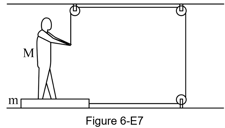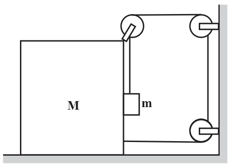The friction coefficient between the board and the floor, shown in the figure, is Find the maximum force that the man can exert on the rope, so that the board does not slip on the floor.



Important Questions on Friction
A block is placed over a block and both are placed on a smooth horizontal surface. The coefficient of friction between the blocks is . Find the acceleration of the two blocks if a horizontal force of is applied to
(a) the upper block.
(b) the lower block.
Take .
Find the accelerations and of the three blocks shown in the figure if a horizontal force of is applied on the
(a) block
(b) block
(c) block
Take .

The friction coefficient between the two blocks shown in the figure is but the floor is smooth.
(a) What maximum horizontal force can be applied without disturbing the equilibrium of the system?
(b) Suppose the horizontal force applied is double the value found in part (a). Find the accelerations of the two masses.

The friction coefficient between the two blocks shown in the figure is but the floor is smooth. Suppose the entire system is kept inside an elevator which is coming down with an acceleration of
(a) What maximum horizontal force can be applied without disturbing the equilibrium of the system?
(b) Suppose the horizontal force applied is double the value found in part (a). Find the accelerations of the two masses.


A block of mass slips on a rough horizontal table under the action of a horizontal force applied to it. The coefficient of friction between the block and the table is . The table does not move on the floor. Find the total frictional force applied by the floor on the legs of the table. Do you need the friction coefficient between the table and the floor or the mass of the table?
Find the acceleration of the block of mass marked in the figure.
The coefficient of friction between the two blocks is and that of between the bigger block and the ground is , respectively.

